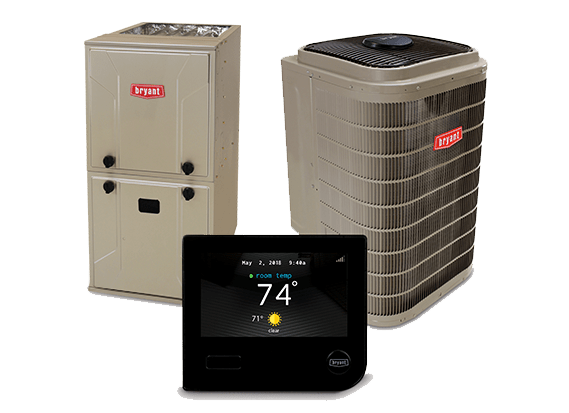SUSTAINABILITY

A SUSTAINABLE FUTURE
At Bryant, our mission is clear: we're dedicated to constructing a sustainable future that benefits everyone. We firmly believe in the mission of safeguarding our planet and recognizing the profound impact the HVAC industry has on the environment. Therefore, we're steadfast in our commitment to acting as stewards for the long haul, surpassing minimum regulatory standards both in our product offerings and industry efforts, ensuring responsible environmental care.

Leading The Way With HVAC Solutions
Every time we embark on designing a new product or enhancing an existing one, we are mindful of the environmental implications. We establish stringent environmental performance targets and leverage cutting-edge innovations to build the most sustainable, energy-efficient, comfort solutions to homeowners around the world.
Decarbonization
Decarbonization encompasses various strategies aimed at diminishing carbon emissions. These include electrification, the adoption of lower Global Warming Potential (GWP) refrigerants, heightened energy efficiency standards, decreased dependence on fossil fuels and natural gas, and amplifying reliance on clean energy sources. Let's delve deeper into how each of these strategies contributes to the broader goal of reducing carbon emissions.

Electrification
Efficiency Optimization
This entails the installation and utilization of higher efficiency electric appliances, HVAC equipment, vehicles, and other relevant items. The Inflation Reduction Act of 2022 offers tax credits to incentivize the adoption of higher efficiency HVAC systems. Additionally, numerous local utility companies are supporting this effort by providing rebates for the purchase of ENERGY STAR® certified appliances, including those offered by Bryant.

Lower GWP Refrigerants
HVAC systems utilizing refrigerants with higher GWP ratings may contribute to carbon emissions due to refrigerant leaks into the atmosphere. Bryant’s preferred refrigerant, Puron Advance™, stands as the optimal solution for reducing environmental impact and energy consumption, as it boasts a low-to-no GWP rating.
The HVAC Industry and Decarbonization
Residential and commercial buildings stand out as major contributors to energy usage and emissions, encompassing both direct emissions and indirect electricity-related emissions.2 Delving deeper, HVAC systems account for over half of the energy consumption in residential settings.3 Through the provision of higher-efficiency, all-electric comfort solutions, HVAC manufacturers like Bryant are poised to play a pivotal part in decarbonization efforts.

Financing Options
We understand the significance of adopting greener practices, and investing in a high-efficiency HVAC system can be a crucial step toward achieving this objective. At Bryant, we are dedicated to ensuring your complete comfort, which is why we offer flexible financing options with convenient monthly payments.4 Explore how Bryant’s EcoHome™ program can assist you in maximizing savings under the Inflation Reduction Act of 2022 while enhancing sustainability. Additionally, take advantage of potential local utility rebates on select products to alleviate the overall cost of installing a new heating and cooling system.
Bryant’s Decarbonized Product Offering
To assist in expediting decarbonization efforts, Bryant presents an extensive array of electric product options, including our acclaimed heat pumps, ductless systems, VRF systems, and geothermal comfort systems. Our all-electric solutions stand ready to supplant natural gas or propane across a wide spectrum of installations and climates. Low GWP refrigerants are integral to our offerings.

Forced Air Heat Pumps
Air-source heat pump technology has undergone significant advancements over the past two decades, resulting in enhanced indoor comfort year-round, regardless of region. Our top-tier heat pumps deliver efficient heating even in freezing conditions. Depending on the model, Bryant heat pumps boast ENERGY STAR® certified efficiencies and incorporate cutting-edge comfort technologies.

Ductless Mini Splits
Our all-electric ductless mini split systems operate with high efficiency, minimizing energy loss commonly associated with forced-air systems (up to 20% of heating/cooling energy can be lost through ductwork).5 Ductless systems also conserve electricity by sending heating or cooling to specific areas rather than the whole house.

VRF Systems
VRF systems link multiple indoor evaporator units to a single outdoor condensing unit. These high-efficiency, all-electric systems offer personalized comfort zoning while reducing energy waste linked to traditional forced-air systems. Distinguished from ductless mini-split systems, VRF systems adjust refrigerant flow to each evaporator unit, delivering simultaneous heating and cooling to different areas.

Geothermal Heat Pumps
Geothermal heat pump systems harness the energy from the homeowner's yard, transferring heat to or from the earth to regulate home temperature. Geothermal energy - a renewable energy source -significantly reduces a home's carbon footprint, with geothermal heat pumps curbing CO2 emissions by 25-65%.6 Geothermal systems can markedly reduce home cooling and heating operating costs compared to forced-air HVAC systems, offering potential savings of up to 70%.7

Hybrid Heat Systems
Since transitioning from a gas furnace to an all-electric solution can present challenges for many homeowners, we offer dual-fuel systems, or HYBRID HEAT® systems as a practical compromise. These systems often entail lower costs than converting an entire home to all-electric. Replacing an older air conditioner with a heat pump can decrease a home's carbon footprint by lessening reliance on gas or propane heating. By combining an electric heat pump with a gas furnace, the system optimizes efficiency by alternating between the two heat sources based on outdoor temperatures.
Want to know more about Bryant's eco-friendly HVAC solutions?
2https://www.nrel.gov/docs/fy17osti/68214.pdf
3https://www.eia.gov/energyexplained/use-of-energy/homes.php
4Subject to credit approval. Ask for details
5https://www.energystar.gov/campaign/heating_cooling/duct_sealing/benefits
6https://www.energy.gov/eere/articles/making-difference-geothermal-heat-pumps
7Savings calculated using LoopLink® software. Comparison based on simulation in Dallas, TX. 6-ton unit vs. standing pilot propane furnace, standard air conditioner and local fuel rates. Actual savings will vary based on configuration, weather, and local energy costs.


